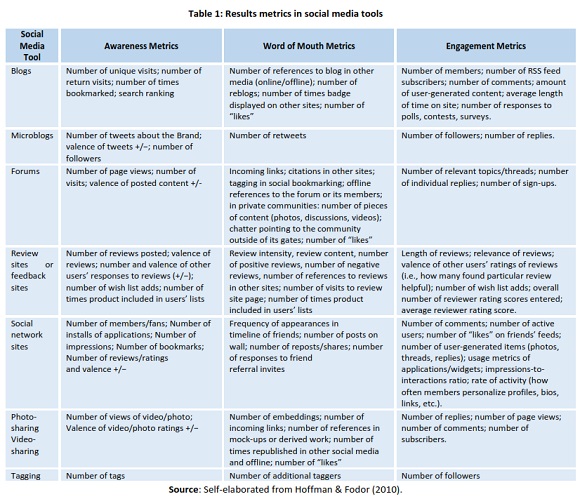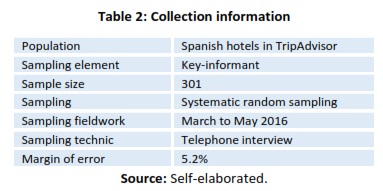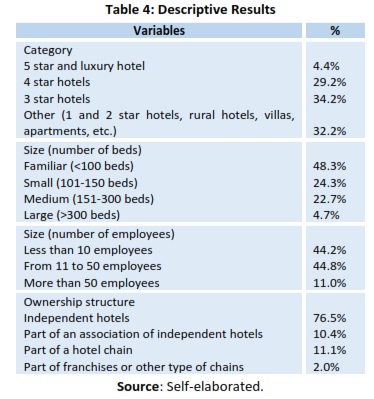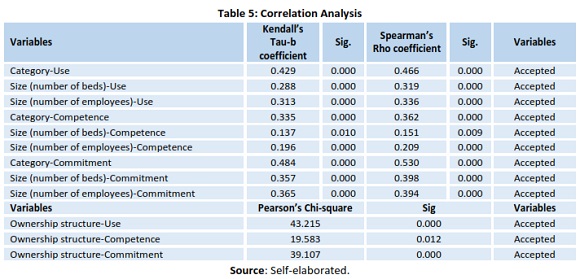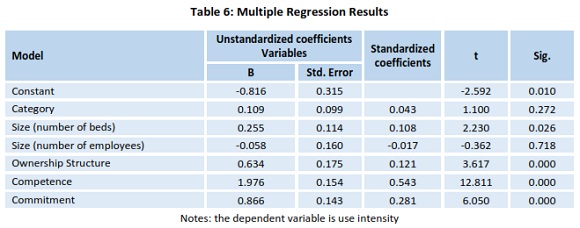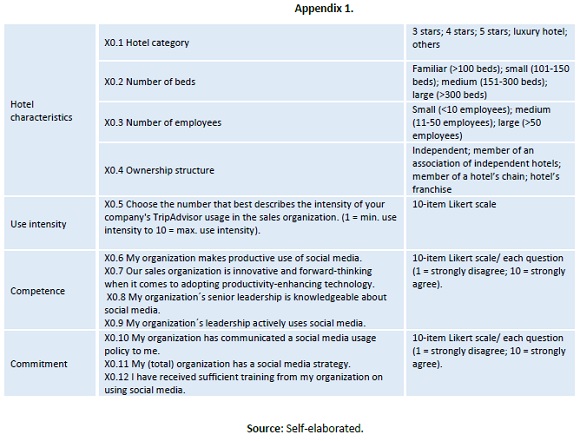Serviços Personalizados
Journal
Artigo
Indicadores
-
 Citado por SciELO
Citado por SciELO -
 Acessos
Acessos
Links relacionados
-
 Similares em
SciELO
Similares em
SciELO
Compartilhar
Tourism & Management Studies
versão impressa ISSN 2182-8458versão On-line ISSN 2182-8466
TMStudies vol.13 no.2 Faro jun. 2017
TOURISM: SCIENTIFIC PAPERS
Predictors of review sites usage in hotels
Predictores del uso en hoteles de plataformas de valoración
*Javier Perez-Aranda, ** Rafael Anaya-Sanchez, *** Jose Ruizalba
*University of Malaga, Faculty of Economics and Business, Department of Business Management, Campus de Teatinos, 29071 Málaga, Spain, jpereza@uma.es
**University of Malaga, Faculty of Economics and Business, Department of Business Management, Campus El Ejido, 29013 Málaga, Spain, Rafael.anaya@uma.es
***University of Westminster, Westminster Business School, Room M127, 35 Marylebone Road, London NW1 5LS, UK, jruizdealba@gmail.com
ABSTRACT
The tourism industry has been strongly impacted by the consumer use of review sites. Since review travel sites such as TripAdvisor allowed accommodations to create own profiles with information, hotels began incorporating these actions into their engaging customers programming. Despite the benefits that review sites can offer to customers, hotels and accommodations, its implementation is not developed and exploited in all its possibilities, and little is known about hotels use of this review sites. This study explores the topic trough quantitative methodology, conducting multiple correlation analysis of data obtained from a sample of 301 hotel managers. Managers consider they are committed to this type of platforms and are capable of use it accurately. Also it was found evidence of correlation between use of TripAdvisor and hotel characteristics (size, ownership structure, and category). Furthermore, multiple regression analysis shows competence and commitment as the most important predictors of use intensity.
Keywords: Review sites, eWOM, tourism, hotel sector, predictors.
RESUMEN
La industria del turismo se ha visto fuertemente afectada por el uso las plataformas de valoración por parte de los consumidores. Dado que sitios como TripAdvisor permiten a los alojamientos crear perfiles propios, los hoteles han comenzado a incorporar estas acciones en sus programas de compromiso y fidelización de clientes. A pesar de los beneficios que estas webs pueden ofrecer tanto a clientes como a hoteles, su implementación no se ha desarrollado en todas sus posibilidades, y poco se sabe sobre el uso que de ellas hacen los hoteles. Esta investigación explora este tema mediante una metodología cuantitativa, realizando análisis de correlación múltiple con datos obtenidos de 301 gerentes de hoteles. Los gerentes consideran que están comprometidos con este tipo de plataformas y son capaces de usarlas con precisión. Además, encontramos evidencias de correlación entre el uso de TripAdvisor y las características del hotel (tamaño, estructura de propiedad y categoría). Igualmente, el análisis de regresión múltiple muestra la capacidad y el compromiso como los predictores más importantes de la intensidad de su uso.
Palabras clave: Plataformas de valoración, eWOM, turismo, sector hotelero, predictores.
1. Introduction
Tourists increasingly use review sites in their travels decisions. In the tourism sector, the use of review sites such as TripAdvisor is getting crucial as it is said to influence more than US$10 billion in online travel purchases every year (Ye, Law, Gu & Chen, 2011). According to the organization´s factsheet of 2016, over 340 million visitors pass through the site every month. TripAdvisor also offers over 350 million traveller reviews, 1,000,000 hotels and 4,000,000 restaurants (TripAdvisor, 2016). This site provides reviews of travel-related content and allows users to provide feedback on review helpfulness. Moreover, TripAdvisor lets hotels respond and manage responses of reviews.
In the last years, scholars studying TripAdvisor focused on consumer behaviour. Thus, papers which have considered the way how TripAdvisor rankings engender trust (Jeacle & Carter, 2011) also studied: the influence of users reviews in their decision (Verma, 2010), interaction activities and motives (Munzel & Kunz, 2013), helpfulness of reviews (Lee, Law, & Murphy, 2011; O´Mahony & Smyth, 2010), frequency of response (Park & Allen, 2013), type of complaints (Jeong & Jeon, 2008; Levy, Duan, & Boo, 2013; O'Connor, 2010; Sparks & Browning, 2011; Zheng, Youn, & Kincaid, 2009), guest satisfaction and competitive position in the hospitality and tourism industry (Crotts, Mason, & Davis, 2009).
However, more research on the use of TripAdvisor and in how to measure its results is needed (Garrido-Moreno & Lockett, 2016). According to Baka (2016), the route to reputation standing for hoteliers necessarily entails relationships to and with TripAdvisor and other Word of Mouth (WOM) websites. In her work, Baka recognized social media as a category under reputation management umbrella that deserves distinctive attention. For Baka, the general public (the general crowd) has been empowered more than ever before to create realities, rather than to simply influence them. In this sense, Williams and Buttle (2014) conclude that there is very little research on how organizations attempt to manage WOM.
In order to fill this gap, this research contributes to this emerging literature by analysing correlation between use of TripAdvisor and hotel size (employees and number of beds), hotel category, and ownership structure, in addition to its relationship with commitment to this platform and competence using it. Moreover, a multiple regression analysis is developed to study predictors of use of TripAdvisor in sales. Therefore, this investigation poses the following objectives: to examine how hoteliers use TripAdvisor to engage customers and to provide empirical evidence of the most important predictors of use of TripAdvisor in sales.
To do so, this paper is organized in three sections. Firstly, a literature review of TripAdvisor and social media use for engagement in sales in hotel industry is done. After the literature review process, it is described the methodology and the main results. Finally, conclusions and discussion are included.
2. Literature review
2.1 Social media
There is no a universally adopted definition of social media, thus social media has been defined in several times. It is sometimes being equated with other terms such as social websites, consumer-generated media, user-generated content, and even Web 2.0 (Chan & Guillet, 2011). In this sense, Kaplan and Haenlein (2010, p. 61) defined social media as “a group of Internet-based applications that build on the ideological and technological foundations of Web 2.0, and that allow the creation and exchange of User Generated Content”. Other accepted definition of social media describes it as a formed group of online tools that allow social interaction between users, facilitating creation and sharing of knowledge, and transforming monologue into dialog (Hansen, Shneiderman & Smith, 2011). Andzulis, Panagopoulos and Rapp (2012, p. 308) define social media in a selling context as “the technological component of the communication, transaction and relationship building functions of a business witch leverages the network of customers and prospects to promote value co-creation”. For this study, social media can be defined as a group of Internet-based applications that exist on the Web 2.0 platform and enable the Internet users from all over the world to interact, communicate, and share ideas, content, thoughts, experiences, perspectives, information, and relationships (Briscoe, 2009; Chan & Guillet, 2011; Kaplan & Haenlein, 2010; Scott, 2007; Tylee, 2009; Xiang & Gretzel, 2009).
In practice, there are different types of social media tools (specific platforms through which people communicate). This types of social media are differently classified by scholars, in one hand, the authors whom distinguish between discussion forums, blogs, wikis, social networks and multimedia sites (Bradley & Barlett, 2011; Gupta, Amstrong, & Claydon, 2011) and, in the other hand, those who distinguish between instant messaging, blogs, microblogs, social networkink sites, wikis, photo and video sharing sites, review sites, tagging and news feed (Berthon, Pitt, Pangger, & Shapiro, 2012; Hansen et al., 2011; Munar & Jacobsen, 2014).
This paper focuses on TripAdvisor, classified as a review site or site dedicated for feedback. This type of social media tool is a website where users are allowed to post, read, review, respond, discuss, and share experiences, opinions, and thoughts on a myriad of topics (Wunsch-Vincent & Vickery, 2007).
2.2 Social media uses in marketing
Marketing strategies in social media can be defined as “a social and managerial process by which individuals and groups obtain what they need and want through” (Kotler, Bowen, & Makens, 2006, p. 7). According to Guesalaga (2016), social media marketing is a set of Internet-based tools that enable interaction, communication, collaboration of user-generated content and hence, sharing of information such as ideas, thoughts, content, and relationships.
Even managers are connoisseur of the utility and all uses of social media they cannot find a direct ROI of it (Garrido-Moreno & Lockett, 2016). In this sense, Chan and Guillet (2011) argued that it remains unknown whether social media could actually bring financial returns that justify the invested resources on it. Since measuring productivity from social media tools seems difficult, hotels focus on receiving a "return on engagement" as opposed to a return on investment (Jung, Ineson & Green, 2013). Despite of it, according to Hoffman and Fodor (2010), social media enable marketers to develop social media programs that tackle awareness, engagement and WOM objectives. Social media applications can fulfil any of these objectives, where the appropriate set of metrics to measure the ROI of the social media marketing depends on the objective: awareness, word of mouth and engagement.
As shown in Table 1, the use of review sites can focus on achievement different marketing goals, in any case the sole presence and management of review site metrics (i.e. reviews, responses and ratings) can be defined as the intensity with which this social media tool is used in the organization (Guesalaga, 2016).
2.3 Predictors of review sites usage
In order to measure if some characteristics of the hotel are associated with a most intense use of review sites and to measure the predictors of review sites, based on previous research, the following dimensions were included in the questionnaire: review sites use level (Garrido-Moreno & Lockett, 2016; Guesalaga, 2016), commitment and competence, factors collected from the international theory according to Guesalaga methodology (Guesalaga, 2016), and ownership structure, category and size (Garrido-Moreno & Lockett, 2016). Although these previous researches measure the use of social media organizations in general, in this study, we apply these predictors just in a particular social media tool: review sites.
Previous studies on information technology adoption suggest that expertise in information technology is a main antecedent of organizational innovation adoption (Hameed, Counsell, & Swift, 2012). Thus, according to Guesalaga (2016), the competence in social media is measured studying the supplier company's knowledge about social media (through productive use, active use, technology adoption and knowledge) and the commitment to review sites is measured studying the extent to which the company has invested resources in review sites, as well as developed and communicated a strategy about its use (through training, planning, and communication).
Moreover, in the hotels industry the implementation of technological innovations has been related to hotels size and chain management integration but not to number of stars (Garrido-Moreno & Lockett, 2016; Haro del Rosario, Gálvez-Rodríguez, & Caba-Pérez, 2013; Orfila-Sintes, Crespí-Cladera, & Martínez-Ros, 2005).
3. Methodology
To obtain our goal we develop an empirical research. This phase of the study is initiated through a qualitative phase focused on the development of the scales. Thus, the scales designed were presented to hotel managers, marketing professionals and academics. Interviews with 6 hotel managers, 3 marketing professionals and with 4 academic experts were made. As a result of this process, the questionnaire was redesigned for the better understanding of the respondent. To collect the information, we followed the key-informant methodology, choosing the hotel managers as informants. In Table 2 is shown the technical specifications of fieldwork conducted.
Using a directory of TripAdvisor with 1,978 Spanish hotels consulted on-line in March 2016, we have focused our analysis on a margin of error of 5%, so final sample designed was 335 hotels. The collection of information within this target population was performed using a systematic random sampling, so that the first element is chosen randomly from it and others are selected at regular intervals; i.e. systematizes selecting items using a lift coefficient. In this case, we have a population of 1,978 hotels and want to select a sample of 335, so 1,978/335 = 5.9 (lift coefficient). As we work with a finite population the study has estimated a margin of error of 4.7%. After deleting incomplete answers, the sample size was 301 hotels (error of 5.2%). Regarding the fieldwork, the territory collection was Spain (including the Balearic Islands, the Canary Islands, Ceuta and Melilla), surveys were conducted by five interviewers during the months of April and May 2016.
3.1 Variables and dimensions
The questionnaire is based in a total of 12 questions, all characteristics variables including: hotel category, size by number of beds, size by number of employees, ownership structure, use of review sites, competence and commitment to the valuation platforms (see Table 3). The finally questionnaire, obtained after being discussed by the technique of pre-test, is shown in Appendix 1 (at the end of paper).
Telephone interview technique was used for sampling. The survey process, it is carried out through five interviewers, each interviewer made 67 surveys of the total sample.
4. Results
4.1 Descriptive results
The results show in Table 4 have a similar composition of the Spanish hotel industry to the researches of Becerra, Santaló and Silva (2013) and Such-Devesa and Mendieta-Peñalver (2013).
With the aim of simplify the results of this investigation, we have recoded the items related to the use of valuation platforms for sales management, the competence of using valuation platforms and commitment to the valuation platforms, obtaining just a punctuation for each variable, so that the responses could be summarized in high, medium and low. In this regard, hotel's owners consider that their use of valuation platforms (50.5% consider that is high) and their competence using valuation platforms (65.8% point out that is high) are quite elevated, with punctuations over 7 on all of their items. In relation to their commitment to the valuation platforms, hotel's owners showed lower punctuations, but 51.2% answered that is high, and all of the items got punctuations over 6.
4.2 Correlation analysis
In order to reach one of the objectives of this research, a correlation analysis was conducted. Considering that the types of variables employed are ordinal, the coefficients Kendall's Tau-B and Spearman's Rho were used. Both statistics are nonparametric correlation coefficients which measure the dependence between two categorical variables. Their value can vary between -1 and 1: a value of 1 indicates a perfect positive linear relationship; a value of -1 indicates perfect negative linear relationship; while a value of 0 indicates no linear relationship. Hence, both variables are correlated when the probability of the associated t-statistic is lower than 0.05. For the variable ownership structure, as it is a nominal variable, a chi-square analysis was conducted for studying the association with use intensity, competence and commitment. Table 5 shows the statistical values of Kendall's Tau-B, Spearman's Rho, and Pearson's chi-square, including their significances. We should note that we have used the modified variables mentioned above.
From the results, we can conclude that all the variables concerning the characteristics of the hotels (i. e. category, size measured by the numbers of beds and the number of employees, and ownership structure) are correlated/associated with the use of valuation platforms. This relationship is positive, so that hotels with a higher category, larger numbers of beds and employees make a higher use of these platforms. Regarding the ownership structure, hotels which are part of a chain or an association, shows a higher use of these platforms than those which act independently. In the same way, competence using valuation platforms and commitment to use valuation platforms are higher in hotels with larger size and higher category, and in those which are integrated in hotel associations or chains. These results are in line with previous researches, which studied the use of social media in hotel industry (e. g. Garrido-Moreno & Lockett, 2016; Guesalaga, 2016; Haro del Rosario et al., 2013).
4.3 Multiple regression analysis
With the aim of study and the variables which explain the use intensity of valuation platforms, a multiple regression analysis was performed. Thus, use intensity was used as dependent variable, while the remaining variables were considered as independent as all of them are correlated to the dependent variable. The regression was formulated as follows:
Intensity use = β0+ β1CATEG + β2BEDS + β3EMPLOY + β4OWNER + β5COMPET + β6COMMIT + Ɛ
Table 6 presents multiple regression results.
Notes: the dependent variable is use intensity
First, we have to explain that, for this analysis, use intensity has been measured by the 10-item likert scale in order to a better explanation of this variable, so that we considerer this variable as quantitative. On the other hand, for competence and commitment we employed the modified variables. In the case of ownership structure, as it is a nominal variable, it has been recorded into a dichotomic variable, where 0 means independent hotel and 1 means hotel associated to any type of chain. Regarding autocorrelation, Durbin-Watson test was close to 2 (1.699), so data is not autocorrelated. Moreover, for studying the multicollinearity, the condition index was conducted. It was 19.656, so is in the limit considered by Belsley (1991). The model explains the 86.6% of the variance in use intensity (R2 = 0.866). According to the ANOVA analysis, the value of the F statistic obtained was 49,100, with a significance of 0.000 (<0.005), so we can assume that there is a real effect of these variables on use intensity. The explanatory variables of use intensity were: number of beds, ownership structure, competence and commitment (sig. <0.05). In this sense, competence seems to be the variable with a higher effect on use intensity considering both, unstandardized and standardized coefficients (β=1.976). It also stands out the effect of commitment (β=0.866) on use intensity. These effects are in line with previous researches as Guesalaga (2016), Haro del Rosario et al. (2013), and Orfila-Sintes et al. (2005). Hence, the estimated regression is:
Intensity use = -0.816 + 0.255BEDS + 0.634OWNER + 1.976COMPET + 0.866COMMIT + Ɛ
Finally, the potential existence of common method bias has been analysed. For this reason, we used the procedure offered by Podsakoff, MacKenzie, Lee and Podsakoff (2003). First, we ensured the anonymity of the responses and they weren't conditioned. Moreover, we conducted the Harman one-factor test, obtaining a result in the limit of significant common method bias effects (Podsakoff et al., 2003).
5. Conclusion
Review sites are changing the way hoteliers and customers relate, reaching a main tool in social media usage. Previous research has been very helpful to uncover an array of possible benefits of review sites for customers (e.g., Crotts et al., 2009; Jeacle & Carter, 2011; Jeong & Jeon 2008; Lee et al., 2011; Levy et al., 2013; Munzel & Kunz, 2013; O'Connor, 2010; O´Mahony & Smyth, 2010; Park & Allen, 2013; Sparks & Browning, 2011; Verma, 2010; Zheng et al., 2009), but there is still a gap in the literature that needs more research: predictors of review sites use in hotel industry. This paper explores the use of review sites based on hotels with presence in TripAdvisor and offers key information on the topic, contributing to fill this gap in the literature by studying predictors of review sites use.
Concerning the use of review sites by hotels, it was observed that hotels with a higher category appear as the most active in review sites use. In addition, independent hotels show lower levels of use if they are compare to those which are part of any type of chain or association. It may be due to the owners' profiles and the resources available for them. Moreover, for a similar reason, larger hotels (measure both by the number of beds or employees) performed higher levels of use of TripAdvisor.
In this sense, regarding to the research aims, the first objective was to study the factors that are related to the use of review sites in the tourism services industry (hotels). In this regard, it was found that all variables studied were positively related to a more intense use of review sites. Therefore, category, size (number of beds and number of employees), ownership structure, commitment and competence are variables which are related to the use intensity of review sites. Furthermore, we tested possible correlations between competence and commitment with all the characteristics mentioned before, obtaining similar results. Consequently, competence and commitment seem to be related to hotel's characteristics.
The second objective of the study was to understand the relative importance (predictors) of hotels characteristics in review site uses. We find that the most important predictor of review sites usage is competence, that is, productive use, active use, technology adoption and knowledge. This is an interesting result, because being competence is the main predictor that can help increase the use of review sites, so hotels must pay attention in productive use, active use, technology adoption and knowledge of review sites. The second most relevant variable affecting review sites use is commitment (training, planning, and communication). This is another important finding, because it highlights the relevance of training, planning, and communicating in review sites use. Finally, ownership structure and size (measured in number of beds) are predictors of review sites use, too. Category and size (measured in number of employees) does not appear to be a significant predictor of review sites usage by hotels. So, according to our results, the size measure by the number of beds and the type of ownership structure, impact more on use of review webs as TripAdvisor than other hotel characteristics as category. This conclusion is in line with Garrido-Moreno and Lockett (2016) who stated that larger hotels and those members of chains are more prone to use social media.
The findings of the study shed light into the phenomenon of review sites adoption. Thus, this work makes a relevant contribution to the literature and provides several managerial implications. First, managers can gain valuable knowledge in order to property implement these initiatives to better manage customer relationships through review sites. If hoteliers believe in the benefits of review sites uses, they need to build organizational competence and commitment. It could be developed improving knowledge and expertise in review sites in the company, and by providing the necessary training to acquire relevant knowledge and productivity in using review sites (e.g. studying how to reach different objectives of marketing strategies such as WOM, engagement and awareness). Some companies might explore if senior management in the company know the importance of review sites use. One managerial strategy could be developing competence, but also commitment through an articulate strategy on review sites use and a communication campaign. Promote the use of review sites in the companies may have policies that support and assist employees training on using these sites. Moreover, the whole company must understand the importance of such webs in the image formation process of the tourist, and how they use it in the information searching process.
Some limitations and areas for future research were found during the research process. Firstly, we only study competence and commitment from all factors included in international theory. Others factors have influence on review sites use and they aren't included in this research, such us perceived value, individual commitment or customer engagement, the competitors´ use of review sites. Future research could include other factors (personal and situation factors) from interactional theory. Secondly, the use of cross-sectional data prevents us from addressing the dynamics of time. Thirdly, only key informants were interviewer, but no more information about customers or employee's perceptions were used. Therefore, more research is needed to understand the drivers of review sites use by hotels. Finally, we couldn't reduce the common method bias obtained by Guesalaga (2016), even following his recommendation of using only one social media.
To end, considering that research into review sites, and measure of results need more attention (Garrido-Moreno & Lockett, 2016) and these research limitations, it is suggested: further research studying how to manage review sites efficiently and accurately; how to improve in reaching objectives of awareness, WOM and engagement and how to adapt the culture of the organization to this novel concept.
REFERENCES
Andzulis, J., Panagopoulos, NB. N., Shepherd, C. D. & Tashchian, A. (2014). A Review of Social Media and Implications for the Sales Process. Journal of Personal Selling & Sales Management, 32(3), 305-316.
Baka, V. (2016). The becoming of user-generated-reviews: looking at the past to understand the future of managing reputation in the travel sector. Tourism Management, 53, 148-162. [ Links ]
Belsley, D. A. (1991). Conditioning Diagnostics, Collinearity and Weak Data in Regression. New York: John Wiley & Sons, Inc. [ Links ]
Becerra, M., Santaló, J. & Silva, R. (2013). Being better vs. being different: Differentiation, competition, and pricing strategies in the Spanish hotel industry. Tourism Management, 34, 71-79. [ Links ]
Berthon, P.R., Pitt, L.F., Plangger, K. & Shapiro, D. (2012). Marketing meets Web 2.0, social media, and creative consumers: Implications for international marketing strategy. Business Horizons, 55(3), 261-271. [ Links ]
Bradley, S. P. & Barlett, N. (2011). Social networks: The portals of Web 2.0. Harvard Business School Background Note 708-488. [ Links ]
Briscoe, S. (2009). Social media at the strategic level. Associations Now: The Volunteer Leadership Issue, p. 75. [ Links ]
Chan, N. L. & Guillet, B. D. (2011). Investigation of social media marketing: how does the hotel industry in Hong Knog perform in marketing on social media websites? Journal of Travel and Tourism Marketing, 28(4), 345-368. [ Links ]
Crotts, J., Mason, P. & Davis, N (2009): Measuring guest satisfaction and competitive position in the hospitality and tourism industry. Journal of Travel Research, 48(2), 139-151. [ Links ]
Garrido-Moreno, A. & Lockett, N. (2016). Social Media Use in European Hotels: Benefits and Main Challenges. Tourism & Management Studies, 12(1), 172-179. [ Links ]
Guesalaga, R. (2016). The use of social media in sales: Individual and organizational antecedents, and the role of customer in social media. Industrial Marketing Management, 54, 71-79. [ Links ]
Gupta, S., Amstrong, K. & Clayton, Z. (2011). Social media. Harvard Business School (9-510-095). [ Links ]
Hameed, M. A., Counsell, S. & Swift, S. (2012). A meta-analysis of relationships between organizational characteristics and IT innovation adoption in organizations. Information Management, 49, 218-232. [ Links ]
Hansen, D. L., Shneiderman, B. & Smith, M.A. (2011). Analysing Social Media Networks with NodeXL: Insights from a Connected World. Burlington: Morgan Kaufmann. [ Links ]
Haro de Rosario, A., Gálvez-Rodríguez, M.M. & Caba-Pérez, M.C. (2013). Development of social media and web 2.0 in the top hotel chains. Tourism & Management Studies, 9(1), 13-19. [ Links ]
Hoffman, D. & Fodor, M. (2010). Can You Measure the ROI of Your Social Media Marketing?. MITSloan Management Review. 52(1), 40-50. [ Links ]
Jeacle, I. & Carter, C., (2011). In TripAdvisor we trust: Rankings, calculative regimes and systems trust. Accounting, Organizations and Society, 36(4-5), 293-309. [ Links ]
Jeong, M. & Jeon. M. (2008). Customer reviews of hotel experiences through consumer generated media (CGM). Journal of Hospitality & Leisure Marketing, 17(1-2), 121-37. [ Links ]
Jung, T. H., Ineson, E. M. & Green, E. (2013). Online social networking: Relationship marketing in UK hotels. Journal of Marketing Management, 29, 3-4. [ Links ]
Kaplan, A. M., & Haenlein, M. (2010). Users of the world, unite! The challenges and opportunities of social media. Business Horizons, 53(1), 59-68. [ Links ]
Kotler, P., Bowen, J. T., &Makens, J. C. (2006). Marketing for hospitality and tourism. Upper Saddle River, NJ: Pearson Prentice Hall.
Lee, H., Law, R. & Murphy, J., (2011). Helpful reviewers in TripAdvisor, an online travel community. Journal of Travel Tourism Market, 29, 675-688. [ Links ]
Levy, S. Duan, W & Boo, S., (2013). Analysis of One-Star Online Reviews Responses in the Washington, Lodging Market. Cornell Hospitality Quarterly, 54(1), 49-63. [ Links ]
Munar, A.M. & Jacobsen, J.K.S. (2014). Motivations for sharing tourism experiences through social media. Tourism Management, 43, 46-54. [ Links ]
Munzel, A. & Kunz, W. (2013). Creators, multipliers, and lurkers: who contributes and who benefits at online review sites. Journal of Service Management, 25(1), 49-74. [ Links ]
O'Connor, P. (2010). Managing a hotel's image on TripAdvisor. Journal of Hospitality Marketing & Management, 19(7), 754-72. [ Links ]
O'Mahony, M.P. & Smyth, B., (2010). A classification-based review recommender. Knowledge-based Systems, 23, 323-329. [ Links ]
Orfila-Sintes, F., Crespí-Cladera, R. & Martínez-Ros, E. (2005). Innovation Activity in the hotel industry: Evidence from Balearic Islands. Tourism Management, 26(6), 851-865. [ Links ]
Park, S. & Allen, J. (2013). Responding to Online Reviews: Problem Solving and Engagement in Hotels. Cornell Hospitality Quarterly, 54(1) 64-73. [ Links ]
Podsakoff, P., MacKenzie, S. B., Lee, J. -Y. & Podsakoff, N. (2003). Common method biases in behavioral research: A critical review of the literature and recommended remedies. Journal of Applied Psychology, 88(5), 879-903. [ Links ]
TripAdvisor (2016). Fact sheet. Retrieved April 15, 2016 from http://www.TripAdvisor.com/PressCenter-c4-Fact_Sheet.html [ Links ]
Scott, D.M. (2007). Social media debate. EContent, 64. [ Links ]
Sparks, B. & Browing, V. (2011). The impact of online reviews on hotel booking intentions and perception of trust. Tourism Management, 32(6), 1310-1323. [ Links ]
Such-Devesa, M. J. & Mendieta-Peñalver, L. F. (2013). Research note: Size, efficiency and productivity in the Spanish hotel industry - independent properties versus chain-affiliated hotels. Tourism Economics, 19(4), 801-809. [ Links ]
Tylee, J. (2009). Adland's social revolution. Campaign (UK), pp. 22-23. [ Links ]
Verma, R. (2010). Customer choice modeling in hospitality services: A review of past research and discussion of some new applications. Cornell Hospitality, 51(4), 470-478. [ Links ]
Williams, M. & Buttle, F. (2014): Managing negative word-of-mouth: an exploratory study, Journal of Marketing Management, 30, 13-14. [ Links ]
Wunsch-Vincent, S. & Vickery, G. (2007). Participative web and user-created content: Web 2.0, wikis and social networking. Paris, France: OECD. [ Links ]
Xiang, Z. & Gretzel, U. (2009). Role of social media in online travel information search. Tourism Management, 31(2), 179-188. [ Links ]
Ye, Q., Law, R., Gu, B. & Chen, W. (2011). The influence of user-generated content on traveler Zheng, T., Youn, H. & C. Kincaid. (2009). An analysis of customers' e-complaints for luxury hotel properties. Journal of Hospitality Marketing & Management, 18(7), 718-729.
Received: 15.05.2016
Revisions required: 23.10.2016
Accepted: 12.11.2016













